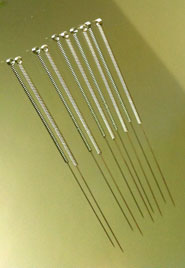Fergie, now pregnant, recently announced that she uses acupuncture and Chinese herbal medicine to control her morning sickness. Let’s look at why this pop star loves acupuncture and Chinese herbal medicine. Morning sickness is characterized by nausea and vomiting. Modern research shows that acupuncture at acupuncture point P6, located on the forearm, significantly reduces nausea and vomiting. Many other studies demonstrate that herbs such as ginger, known as Sheng Jiang in Chinese medicine, are beneficial for the control of nausea and vomiting.
 Acupuncture NeedlesResearchers from Baltimore, Maryland and from the University of Heidelberg, Germany published their findings that acupuncture P6 is effective for the treatment of nausea and vomiting. The researchers investigated patient outcomes of thousands of patients suffering from nausea and vomiting due to postoperative sickness, pregnancy related sickness, and chemotherapy induced nausea and vomiting. Manual acupuncture and electroacupuncture demonstrated significant clinical results. Acupressure at P6 showed some results and wristwatch electrical stimulators of P6 were not effective. As a result of the finding, the researchers recommended continuing investigation of the effectiveness of Traditional Chinese Medicine (TCM) for the treatment of nausea and vomiting. The researchers also noted that the National Institutes of Health Consensus Statement on Acupuncture acknowledged the efficacy of acupuncture for the control of postoperative and chemotherapy induced nausea and vomiting.
Acupuncture NeedlesResearchers from Baltimore, Maryland and from the University of Heidelberg, Germany published their findings that acupuncture P6 is effective for the treatment of nausea and vomiting. The researchers investigated patient outcomes of thousands of patients suffering from nausea and vomiting due to postoperative sickness, pregnancy related sickness, and chemotherapy induced nausea and vomiting. Manual acupuncture and electroacupuncture demonstrated significant clinical results. Acupressure at P6 showed some results and wristwatch electrical stimulators of P6 were not effective. As a result of the finding, the researchers recommended continuing investigation of the effectiveness of Traditional Chinese Medicine (TCM) for the treatment of nausea and vomiting. The researchers also noted that the National Institutes of Health Consensus Statement on Acupuncture acknowledged the efficacy of acupuncture for the control of postoperative and chemotherapy induced nausea and vomiting.
This is not a lightweight matter. Nausea and vomiting can be every bit as serious as pain. The proven efficaciousness of acupuncture for the treatment of both nausea and vomiting suggests that patients suffering from these ailments are better served if acupuncture is provided. For chemotherapy patients, acupuncture can be the difference between living a normal life versus suffering tremendously. For expectant mothers, the availability of acupuncture can be the difference between becoming bedridden or hospitalized versus enjoying a healthy pregnancy. For postoperative patients, nausea and vomiting is also a major concern. In an extensive investigation, researchers concluded that acupuncture at P6 is effective in reducing or eliminating postoperative nausea and vomiting.
Acupuncturist Shop Talk
Acupuncture point P6, Neiguan, is translated as inner pass. It is located 2 cun above the transverse wrist crease between the tendons of m. palmaris longus and flexor carpi radialis. It is the Luo (Connecting) point of the Pericardium channel and the Confluent point of the Yin Wei (Yin Linking) channel. According to Traditional Chinese Medicine theory, P6 calms the Heart and spirit, regulates Qi and suppresses pain.
Common indications for the use of P6 include cardiac and chest pain, palpitations, stomachache, nausea, vomiting, hiccups, mental disorders, epilepsy related seizures, fevers and insomnia. P6 is commonly used in combination with SP4, the Confluent point of the Penetrating channel, for the treatment of abdominal and epigastric distention, fullness and pain. P6 may also be manually manipulated to slow or speed up the heart beat rate dependent upon the acupuncture technique applied. Notably, P6 is considered one of the most important distal acupuncture points for the treatment of chest related disorders. The median nerve is under P6 and acupuncture needling may elicit an eletric sensation indicating that further manipulation of the needle is not required and should cease in order to avoid overstimulation of the nerve region.
References:
Ezzo, Jeanette, Konrad Streitberger, and Antonius Schneider. "Cochrane systematic reviews examine P6 acupuncture-point stimulation for nausea and vomiting." Journal of Alternative & Complementary Medicine 12.5 (2006): 489-495.
Ernst, E., and M. H. Pittler. "Efficacy of ginger for nausea and vomiting: a systematic review of randomized clinical trials." British journal of anaesthesia 84.3 (2000): 367-371.
Lee, Anna, and L. T. Fan. "Stimulation of the wrist acupuncture point P6 for preventing postoperative nausea and vomiting." Cochrane Database Syst Rev 2 (2009).

